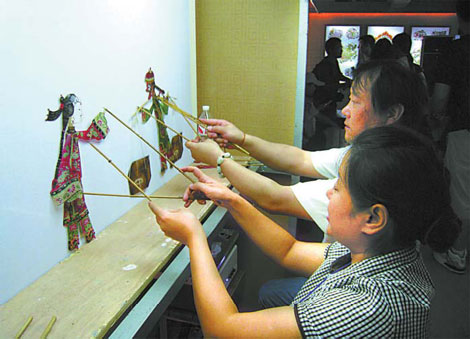
Shadow play masters stage a show for visitors. Chen Xiaorong
Thirty white huts dot the east side of the Olympic Center District in a bid to showcase China's rich and diverse traditional culture.
The exhibition entitled China Stories aims to promote intangible Chinese culture and heritage, including folk customs, dance, music and handicrafts from nearly all of the country's 30 provinces.
The huts, referred to as xiangyun (auspicious cloud), are sectioned off into corners representing different provinces and autonomous regions in China. Organized by The Ministry of Culture and the Beijing Organizing Committee, the exhibition, which opened to the public on Augusts 8, will last until the end of the Paralympics.
Noted celebrities such as Jackie Chan, who is a huge fan of Chinese culture, paid a visit to the exhibition and recorded a theme song for the event called China Witness. China Daily brings you the first series of articles featuring a look inside the various xiangyun huts.
Shaanxi Hut

At the Shaanxi House in the Olympic Park, many of the provincial traditions are on display for tourists. The house features Shaanxi's renowned paper-making invention and puppet play art.
"By using real objects, multimedia audio-visual art and combining interaction with audience, (the hut) strives to show the beauty and uniqueness of Shaanxi's traditional culture," says Sa Xiaohu, an official from the culture department of the province who is helping manage the hut.
Sixty-nine-year-old peasant Zhang Fengxue skillfully uses a knife to cut out parts of a special tree needed to make paper - displaying the ancient process of the Chinese invention.
Various tools and devices used in the paper-making process including a stone sink, paper-lifting sift, steamer, pestle and mortar, are on display for visitors.
Two senior villagers from Beizhang village in Shaanxi province, renowned for its paper-making tradition, show visitors their ancient technique.
As the capital of 13 dynasties, Xi'an, the provincial capital of Shaanxi, is the cradle of Chinese civilization. Paper-making, one of the top four great ancient Chinese inventions, came into being in the Chinese West Han Dynasty (BC206-25AD).
Today, traces of the technique still can be found in Beizhang village. Since the Qing Dynasty (1644-1911), paper produced from the village was made exclusively for official use. The paper is very soft and elastic-like. It is made from mulberry, which grows in abundance around the village. Visitors are invited to rub and stretch the newly produced paper.
Nearby, behind a white cloth-screen in the Shaanxi House, the province's shadow play master Liu Yingzhe and his partner are busy manipulating two shadow play puppets.
They are performing a play called Vendor which tells the story of a man who was engaged under the decision of his parents. He is restrained from seeing his fianc before the wedding ceremony due to tradition, so he dresses up as a female vendor to spy on his soon-to-be wife.
Originating from the Han Dynasty (BC206-220AD), Shaanxi's shadow play has rich content, profundity in cultural connotation with peculiar sculpt and masterly carving.
In the Yuan Dynasty (1206-1368), Shaanxi's shadow play had developed into its peak period. It was not only popularized in folk but also developed into recreation activities in the army. From that time onwards, Shaanxi's shadow play grew in popularity across the entire country.